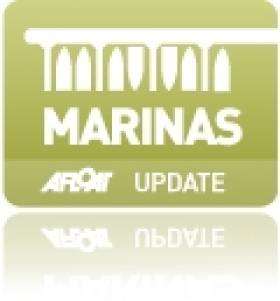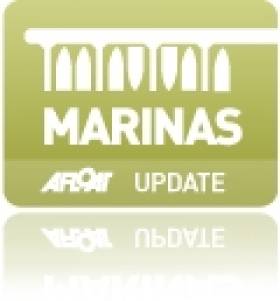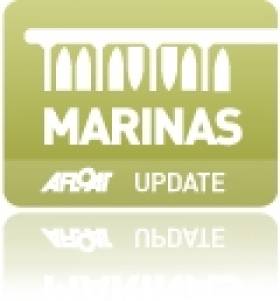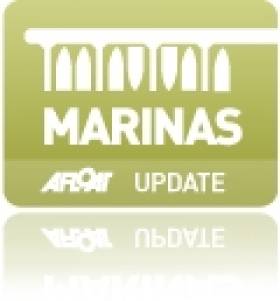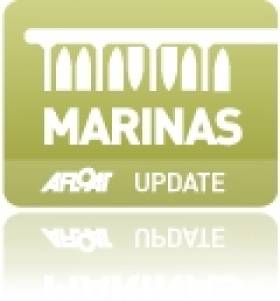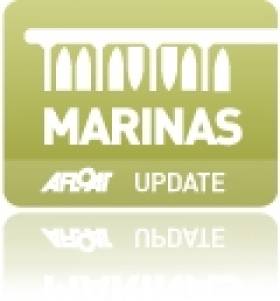Displaying items by tag: Irish Marinas
Ten Irish marinas were awarded a Blue Flag in Ireland in 2023, nine of these have retained Blue Flag status for the coming season.
The Blue Flag awarded to Greencastle Marina in 2023 was withdrawn by Donegal County Council in July 2023 as construction works at the harbour on a breakwater necessitated closure of the seasonal marina there. There was no application for Greencastle Marina for 2024.
An Taisce announced the International Blue Flag and Green Coast Award recipients for 2024. The awards were presented by Hildegarde Naughton TD - Government Chief Whip and Minister of State at the Department of Education at a ceremony held in the Galway Bay Hotel overlooking Salthill Blue Flag beach this afternoon.
 Blue Flag Marina Awards 2024
Blue Flag Marina Awards 2024
Speaking at the awards ceremony Minister Naughton, who presented the award flags said: “It is my great pleasure to congratulate all of the recipients of International Blue Flags and Green Coast Awards today. For Ireland to be the home of 94 Blue Flags across the length and breadth of our beautiful beaches and marinas. As a Galway Minister, I am particularly proud to see the return of the Blue Flag to one of my own local swimming spots, Traught Beach in Kinvara, I know that this will be of particular note and celebration for many Galway swimmers.”
Continuing, Minister Naughton said: “As we get warmed up for the bathing and swimming season this year we are breaking the record with some 70 Beaches receiving the Green Coast Award. We all know just how lucky we are to have such beautiful water quality and natural beauty across our shores and this year’s recipients are testament to just how exceptional and rich in diversity that our beaches are. Congratulations to everyone involved and I want to wish a very happy and safe bathing and swimming season to everyone for 2024.”
 Blue Flag Awards 2024
Blue Flag Awards 2024
Talking at the event, Ms. Cathy Baxter, Director of the Environmental Education Unit of An Taisce, said: “We were delighted to be welcomed to Salthill, a Blue Flag and Green Coast Award beach for many years, for the opportunity to celebrate the beaches and marinas awarded for the 2024 season. The Local Authorities, marina operators and Clean Coasts groups responsible for their management have worked tirelessly to ensure that these sites meet the excellent standards required by The Blue Flag and Green Coast Award. I would like to congratulate all the awardees on their success, and to thank Galway City Council for hosting us here today.”
Blue Flag
The Blue Flag is one of the world’s most recognised environmental awards. Originating in France in 1985 it was launched as an International programme as part of the "European Year of the Environment in 1987. In 1988, the first year sites were awarded outside of France 19 beaches and 2 marinas received the Blue Flag in Ireland. 2024 is the 37th year that beaches and marinas have been awarded here in Ireland, with 94 beaches and marinas being awarded for the 2024 season.
The programme aims to raise environmental awareness and promote sound environmental management of beaches, marinas and eco-tourism boats around the world. The 85 Irish beaches and 9 marinas that have achieved this accolade must adhere to specific criteria related to water quality, information provision, environmental education, safety and site management for the duration of the bathing season.
Blue Flag 2024 in numbers: 85 Beaches and 9 marinas awarded the Blue Flag for 2024
- 3 beaches not awarded in 2023 have been awarded for the coming bathing season. These are: Bettystown Beach; Enniscrone Beach and Traught in Kinvara.
- Bettystown Beach in Meath has been awarded a Blue Flag for the first time since 1996 this year.
- Enniscrone in Sligo is being awarded for the first time since 2014.
- Traught has regained Blue Flag status last held in 2021.
- 82 of the 85 beaches awarded in 2023 have retained Blue Flag status for the 2024 bathing season.
- The 3 beaches, awarded in 2023 that have not been awarded for the 2024 season are: Rush South Beach in Fingal, Ballymoney North Beach in Wexford and Tramore in Waterford. The Blue Flag Programme requires that beaches being awarded for the upcoming season have achieved Excellent bathing water quality in the most recent annual classification. Each of the sites received a classification of “Good”, the second highest classification available based on analysis of bathing water samples over the past four bathing seasons.
- 10 marinas were awarded a Blue Flag in Ireland in 2023, 9 of these have retained Blue Flag status for the coming season. The Blue Flag awarded to Greencastle Marina in 2023 was withdrawn by Donegal County Council in July 2023 as construction works at the harbour on a breakwater necessitated closure of the seasonal marina there. There was no application for Greencastle Marina for 2024.
Winter Berths Options For 2015-16 Season
#WinterBerths - The winter mooring period for 2015-16 is coming up fast, and Ireland's boat owners will undoubtedly be looking for the best deals available.
Last week we put out a call for details on winter packages available from Ireland's marinas and harbours, and those in the Dublin area can benefit from the most options.
As previously reported, Howth Yacht Club got a head start on the competition with their comprehensive winter package, which includes access to the club's full range of facilities and marine services. A few kilometres north, Malahide Marina also offers special rates for winter berthage.
On the south side of Dublin Bay, winter boat storage is always at a premium. But Dun Laoghaire Marina presently has two deals on offer, with winter berthing on the marina for €135/m, as well as a combined package with MGM Boatyard for discounted marina berthing plus lift-out and anti-foul (call 01 202 0040 for details).
The 5 Gold Anchor marina also hosts a full calendar of winter racing with the Dublin Bay Sailing Club for those who may not want to hang up their sailing gear just yet.
It also emphasises that its staff check the marina's moored boats daily to avoid such catastrophes as the grounded yacht off Hook Head last week, which is thought to have slipped free of its moorings.
At the Royal St George, winter lift-out comes early – on Saturday 10 October, just over a week from now – with winter parking allocated on a first come, first served basis. In addition, the club reminds that the usual members rate is not available this season. More details can be found HERE.
Nearby, Western Marine at Dalkey's Bullock Harbour has had a number of upgrades for its latest winter storage season, with its crane once again fully operational (€50 per standard lift-out of 3.5 tonnes and under).
Mains power is available, with no additional cost for use of light power tools, and water can be sourced from a public tap outside the entrance. More details of their services and rates, including special offer discounts, are available HERE.
Further down the coast, Greystones Harbour Marina is providing winter berthing from October to March for €185 per metres. And in the city centre, Poolbeg Marina in Ringsend sees its winter berthing season begin this Thursday 1 October, with rates from €100 per metre.
It's a similar story around the country, with the venerable Royal Cork, for example, offering a rate €25 per foot for winter storage from 1 November.
On the Shannon Navigation and Shannon-Erne Waterway, the winter mooring period for public harbours begins on 1 November, running till 31 March 2016.
Masters are requested to pay the winter mooring fee of €63.50 before 1 November, and are reminded that the 'five-day rule' still applies for those not wishing to avail of winter mooring.
Those looking for some more security for their vessels will want to go private. Butlers Marina in Carrick-on-Shannon offers indoor winter berthage in its secured marina, while Manor Marine on Lough Erne offers both hard stand storage and winter berthing.
And it's not just boats that need berthing or storage or winterising over the coming months.
Rather than leave your lifejackets on board to risk getting damp and attracting mildew while you're not using them, why not have them stored safety by professionals?
Boaters in the UK at least can benefit from SeaSafe's offer of winter lifejacket servicing from over 50 centres around Britain. Servicing starts at £9.95 and SeaSafe will store your PFD till you need it when the 2016 season arrives - or any time in between.
If there are any Irish operations that offer a similar service, we'd love to hear from you.
And if you're a harbour or marina operator with winter berths to offer this season, please leave your details with us (below in comments) or email to [email protected] so they can be added here.
Portmagee Marina Pontoons Set For Second Season in County Kerry
#irishmarinas – Portmagee Marina pontoons are set for a second season of operation, built by L&M Keating Ltd, for Kerry Co Council, the 20–berth facility was opened in 2014 in the pretty port of Portmagee.
It is operated by Kilrush Marina who also operate the 120–berth County Clare facility. Most of the berths are occupied by the fleet of Skellig passenger boats that operate from Portmagee, however there are a number of berths reserved for visitors which have proved to be a very popular overnight stop off for cruising yachts during 2014.
Portmagee offers a 'traditional Kerry welcome' and the marina is situated 50m from the village main street and across the road from the popular Moorings Bar and Restaurant run by Gerard Kennedy who manages the marina. Gerard can be contacted on 087 2390010 for anyone wishing to book a berth.
Waterford Marinas Get Funding For Upgrades
#IrishMarinas - Three marinas in Waterford are due for upgrades after Marine Minister Simon Coveney gave approval for nearly half a million euro for capital works projects in the sector.
As Build.ie reports, the funding will go towards three schemes to improve marine leisure and tourism infrastructure in Tramore, Abbeyside in Dungarvan and Boatstrand, covering 75% of costs - with the remainder to be sourced by Waterford County Council.
The announcement follows funding allocations earlier this year for urgent remedial works at six regional harbours, and further harbour improvement projects in Co Clare.
Build.ie has more on the story HERE.
Fortunate Sun Joins Bikini Registered Motoryacht to List of Poolbeg Marina Visitors
#MotorYacht – The impressive 177 foot charter motoryacht M.Y. Fortunate Sun is paying a visit to Poolbeg Marina, Dublin Port and as previously reported she called last week to Cork City Marina, writes Jehan Ashmore.
Constructed with a steel-hull the 851 tonnes yacht has luxurious facilities for 10 guests accommodated in 7 suites and has a crew of 12 crew. The Poolbeg Yacht & Boat Club;s 100-berth marina has seen similar vessels moor along the outer pontoon, among them the 87 foot Bikini registered Cary Ali which could take 8 guests.
In addition the marina which caters for local yachts and pleasure craft also welcomes craft to attend events. Notably, the Old Gaffers Association's 50th Anniversary that was held in June.
Portmagee Harbour Pontoon. Boat Berths in Kerry
After first hatching its harbour plan over five years ago, National Tourism Award winning village Portmagee in County Kerry now looks certain to see a new pontoon finally installed at Portmagee pier in 2013. It will be a further boost for a Kerry already popular with visiting yachts and boats.
The idea is to link the network of facilities that terminate in West Cork with new facilities in County Kerry and Portmagee will be an important link in this process.
The plans are that both local Skellig Rock tourism boat operators and up to 20 visiting yachts at any one time can use the new village pontoon once it is installed.
The facility is being developed through a local community initiative with funding from Kerry County Council and Failte Ireland.
Glenarm Marina. Yachts and Boating Berths in Northern Ireland
Glenarm has long been a port of call for sailors and yachtsmen travelling to and from Scotland's island-studded western coast and has proved a welcoming haven to visitors from all over the world.
Glenarm Harbour offers 40 fully serviced pontoon berths within the village's historical limestone harbour, which is ideally situated within a day's sail of the Western Isles and Clyde. Visiting vessels welcome.
Glenarm Harbour
Glenarm, Co.Antrim, BT44 0EA
Telephone: 028 2884 1285
Lough Swilly Marina. Yacht and boat berths in Northern Ireland
Lough Swilly Marina at Fahan, in County Donegal, warmly welcomes all visitors to the beautiful Inishowen Peninsula. The marina is located between Derry/Londonderry in the North of Ireland and Buncrana in the South along the R238. The village of Fahan is located on the western shores of the Inishowen Peninsula on Lough Swilly, an area of outstanding beauty and a Special Area of Conservation. Public transport passes through the village on a regular basis and it is a short taxi journey to Derry/Londonderry. The City of Derry Airport is nearby.
The Marina, when completed will have the capacity to provide sheltered berthing for 406 boats. It is currently able to provide pontoon berthing for approximately 200 boats of various sizes. Water and electricity are available on the pontoons and there are temporary toilets and showers on site.
Lough Swilly Marina,
Fahan, Co. Donegal, Ireland
Telephone: 00353 (0)74-9360008
Mobile: 00353 (0)86-1082111
Email: [email protected]
Dublin City Moorings
Dublin City Moorings offers a limited service to visiting yachts. Berths must be pre-booked in advance and are available to visitors on a short term basis only following confirmation of bridge lifts from the Harbourmaster's Office. Please note, there are no security, on-shore toilet/shower or other facilities and access is on a shared basis.
BRIDGE LIFTS - IMPORTANT INFORMATION
Intending visitors must contact Dublin Port to arrange for bridge lifts (see information below).
Harbour Master's Department,
Dublin Port Company,
Port Centre,
Alexandra Road, Dublin 1,
Tel: (01) 887 6000.
Rathlin Island Marina. Yacht & Boat Berths in Northern Ireland
Rathlin island marina facilities include a Harbour Master, Marina Facility, Anchorage, Mooring Fee Payable, Fresh Water, Shorepower, Provisions Store, Bar, Restaurant and Slipway.
Rathlin Island is a magnet for sailors, birdwatchers and divers. The island has spectacular cliffs and is renowned for its colonies of puffins, kittiwakes, guillemots and razorbills. The waters around Rathlin have strong tides and are strewn with wrecks, the biggest being the 14000-ton World War I armoured cruiser Drake, torpedoed in 1917. The harbour in Church Bay has pontoon accommodation for ten to twelve yachts. There are a number of small shops, a post office, pubs, restaurant. Ferries to Ballycastle.
Rathlin Island,
Co Antrim, Northern Ireland
Latitude: 55 Degrees 17' 27"
Longitude: -6 Degrees 11' 51"
Rathlin Harbour (Moyle District Council)
Phone 028 2076 8525
E-mail: [email protected]
Website: www.moyle-council.org
Services


























